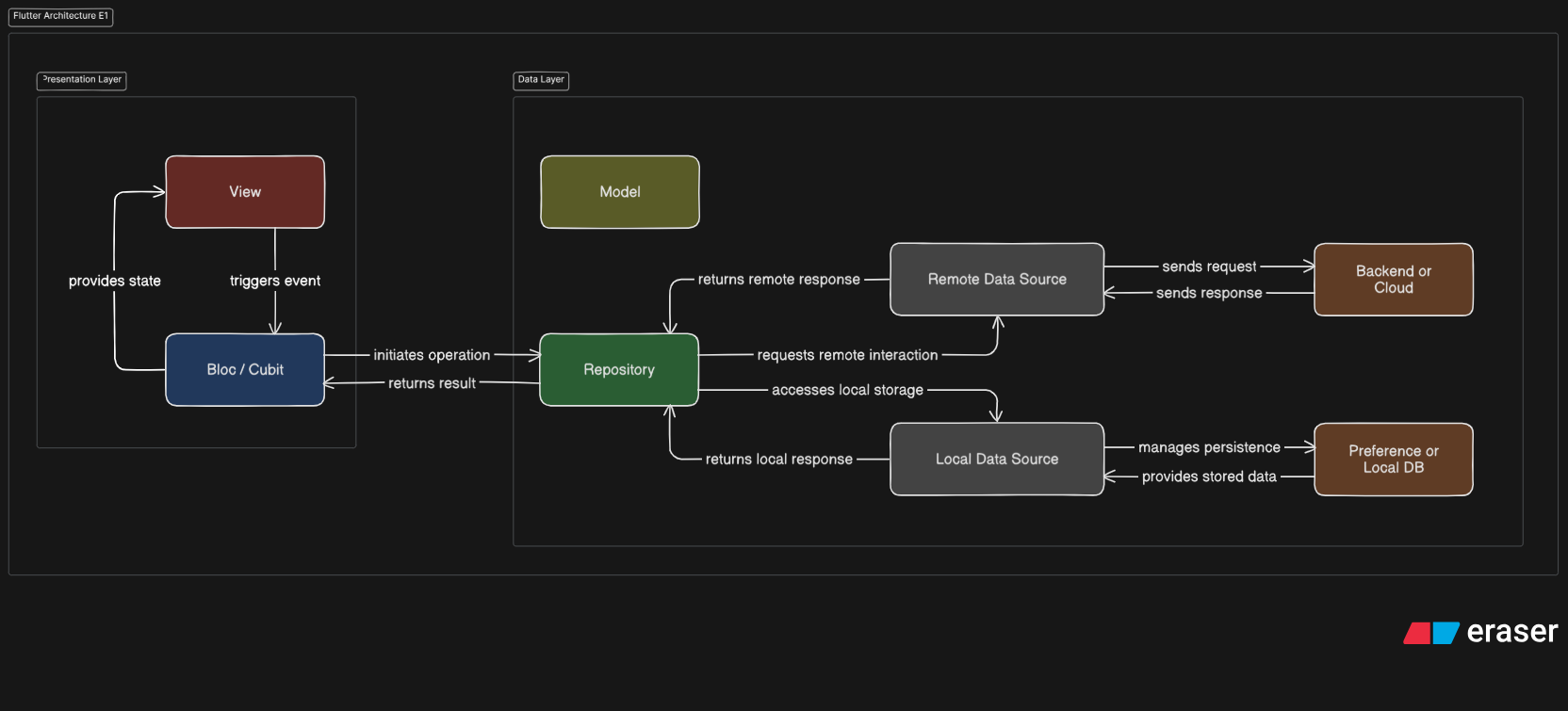Flutter Architecture (E1) Documentation
This document outlines a clean Flutter architecture, separating concerns into Presentation and Data Layers to enhance modularity, testability, and maintainability through clear responsibilities and interactions. But for this architecture (E1), modular only implement within Presentation Layer.

1. Architecture Overview
The diagram details a unidirectional data and event flow, featuring:
-
Presentation Layer: Manages UI display and user input.
-
Data Layer: Handles data retrieval and management (local, remote).
-
Model: Defines application data structures.
2. Components and Responsibilities
2.1. Presentation Layer
-
View (Red Box)
-
Responsibility: Displays UI, renders based on states, and captures user input. It passively reacts to state changes.
-
Interactions:
-
triggers event(to Bloc / Cubit): Dispatches events from user interactions (e.g., taps, text input) for handling. -
provides state(from Bloc / Cubit): Observes and rebuilds UI based on new states emitted.
-
-
-
Bloc / Cubit (Blue Box)
-
Responsibility: Manages application state, processes events, applies business logic, and emits states to update UI, acting as a View-Data Layer intermediary.
-
Interactions:
-
initiates operation(to Repository): CallsRepositoryfor data operations (e.g., fetch, save, delete) based on View events. -
returns result(from Repository):: Receives operation outcomes (data/status). -
provides state(to View): Emits new states toViewafter event processing and result handling, updating UI. -
triggers event(from View):: Receives user action events.
-
-
2.2. Data Layer
The Data Layer manages all data operations, abstracting data sources from business logic.
-
Model (Olive Green Box)
-
Responsibility: Defines application data structures (e.g.,
User,Product). Acts as a pure data container. -
Interactions: Passed between layers (e.g.,
RepositorytoBloc / Cubit).
-
-
Repository (Dark Green Box)
-
Responsibility: Central data source, abstracting data source complexity (remote API, local DB, preferences) from
Bloc / Cubit. Decides between local cache or remote server data fetching. -
Interactions:
-
requests remote interaction(to Remote Data Source): Delegates remote data requests/operations. -
returns remote response(from Remote Data Source): Receives remote data/status responses. -
accesses local storage(to Local Data Source):: Delegates local data requests/operations or data persistence. -
returns local response(from Local Data Source): Receives local data/status responses. -
initiates operation(from Bloc / Cubit): Receives data operation requests. -
returns result(to Bloc / Cubit): Provides consolidated operation results.
-
-
-
Remote Data Source (Dark Grey Box)
-
Responsibility: Manages direct remote service (API) communication, handling network requests, response parsing, and errors.
-
Interactions:
-
sends request(to Backend or Cloud): Sends network requests. -
sends response(from Backend or Cloud): Receives network responses. -
requests remote interaction(from Repository): Receives remote data/operation requests. -
returns remote response(to Repository): Provides processed remote service responses.
-
-
-
Local Data Source (Grey Box)
-
Responsibility: Manages direct communication with local storage (Preference or Local DB) for read/write operations.
-
Interactions:
-
manages persistence(to Preference or Local DB): Performs CRUD operations on local persistent storage. -
provides stored data(from Preference or Local DB): Retrieves and returns stored data. -
accesses local storage(from Repository):: Receives local data/operation requests. -
returns local response(to Repository): Provides processed local storage responses.
-
-
-
Backend or Cloud (Brown Box)
-
Responsibility: External services (APIs, cloud) providing data or server-side logic.
-
Interactions:
-
sends response(to Remote Data Source): Responds toRemote Data Sourcerequests. -
sends request(from Remote Data Source): ReceivesRemote Data Sourcerequests.
-
-
-
Preference or Local DB (Brown Box)
-
Responsibility: Device's local persistent storage (shared preferences for simple data, local database for complex data).
-
Interactions:
-
provides stored data(to Local Data Source): Returns requested stored data. -
manages persistence(from Local Data Source): Receives operations (CRUD) fromLocal Data Source.
-
-
3. Data Flow and Event Propagation
-
User Interaction: View
triggers eventto Bloc / Cubit. -
Event Handling: Bloc / Cubit processes the event, applies business logic, then
initiates operationto the Repository. -
Data Source Selection: Repository determines whether to
requests remote interaction(via Remote Data Source) oraccesses local storage(via Local Data Source) based on data needs or caching. -
Remote Data Flow: If remote data is required, Remote Data Source
sends requestto Backend or Cloud, which thensends responseback. Remote Data Sourcereturns remote responseto Repository. -
Local Data Flow: If local data is needed/stored, Local Data Source
manages persistencewith Preference or Local DB. The storageprovides stored databack, and Local Data Sourcereturns local responseto Repository. -
Result Consolidation: Repository receives responses (remote/local) and
returns resultto Bloc / Cubit. -
State & UI Update: Bloc / Cubit processes the result,
provides stateto **View`, which then updates the UI.
This pattern offers a robust, scalable foundation for Flutter apps, ensuring clear separation of concerns and predictable data flow
4. Project Structure
The project structure which implement this architecture will be look like this:
flutter_app/
└── lib/
├── common/
│ ├── blocs/
│ ├── utils/
│ │ ├── number_util.dart
│ │ └── snackbar_util.dart
│ ├── widgets/
│ ├── app_assets.dart
│ ├── app_colors.dart
│ ├── constants.dart
│ └── enums.dart
├── core/
│ ├── errors/
│ │ ├── exceptions.dart
│ │ └── failures.dart
│ ├── platforms/
│ │ └── network_info.dart
│ ├── app_router.dart
│ └── di.dart
├── data/
│ ├── models/
│ │ └── (e.g., user_model.dart)
│ ├── data_sources/
│ │ ├── local/
│ │ │ └── (e.g., session_data_source.dart)
│ │ └── remote/
│ │ └── (e.g., auth_remote_data_source.dart)
│ └── repositories/
│ └── (e.g., auth_repository_impl.dart)
├── presentation/
│ ├── auth/
│ │ ├── blocs/
│ │ │ └── (e.g., login_bloc.dart)
│ │ └── views/
│ │ └── (e.g., login_screen.dart)
│ └── module2/
│ ├── blocs/
│ │ └── (e.g., module2_cubit.dart)
│ └── views/
│ └── (e.g., module2_page.dart)
└── main.dart
5. Example
See example project: Github